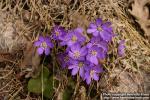
 The leaves of Anemone acutiloba, Lawson, and Anemone Hepatica, Linné.
The leaves of Anemone acutiloba, Lawson, and Anemone Hepatica, Linné.
Nat. Ord.—Ranunculaceae.
COMMON NAMES: Liverleaf, Liverwort, Noble liverwort, American liverleaf, Kidney liverleaf (A. Hep.), Heart liverleaf (A. acut.), Hepatica, etc.
ILLUSTRATION: Lloyd's Drugs and Med. of N. A., Plate V, Figs. 10 to 17.
Botanical Source.—I. ANEMONE HEPATICA (Hepatica americana of De Candolle and Hepatica triloba of Willdenow). This is a perennial plant, the root of which consists of numerous strong fibers. The leaves are all radical, on long, hairy petioles, with 3 ovate, obtuse, or rounded, entire lobes, smooth, evergreen, coriaceous, cordate at base, the new ones appearing later than the flowers. The flowers appear almost as soon as the snow leaves the ground in the spring; are single, generally blue, sometimes white and flesh-colored, nodding at first, then erect, on hairy scapes, 3 or 4 inches long; by cultivation they become double. The involucre is simple and composed of 3 entire, ovate, obtuse bracts, resembling a calyx, and situated a little below the flower, The calyx consists of 2 or 3 rows of petaloid sepals; the stamens are awl-shaped; the anthers elliptic; and the achenia ovate, acute, and awnless (W.—G.).
 II. ANEMONE ACUTILOBA (Hepatica acutiloba) differs in having the leaves with 3 ovate and pointed lobes, or sometimes 5-lobed; leaves of the involucre acute or acutish (G.).
II. ANEMONE ACUTILOBA (Hepatica acutiloba) differs in having the leaves with 3 ovate and pointed lobes, or sometimes 5-lobed; leaves of the involucre acute or acutish (G.).
History and Description.—The Anemone Hepatica has been viewed as the only species of this genus, the differences observed as to color, form, etc., being looked upon as fortuitous. De Candolle, however, divided it into two species. These plants are common to the United States, growing in woods and upon elevated situations; the A. Hepatica (H. americana), which is the least common, being found, as Eaton States, on the side of hills exposed to the north, and the other on that facing the south. They both bear white, blue, or purplish flowers, which appear late in March or early in April, and are among the most beautiful and most sought-for of our vernal flowers. The entire plant is employed. It occurs in market in broken masses of leaves, sometimes intermixed with broken roots, and of a green color. It is odorless, and has a subastringent and viscid taste, and yields its virtues to water. The name liverwort sometimes erroneously applied to it, belongs to the cryptogam Marchantia polymorpha, and others of the same family. Undoubtedly it was the demand for the latter plant that led to the wonderful "hepatica boom" about the year 1880. In 1883, the consumption of liverleaf in this country alone was about 450,000 pounds. (For an exhaustive article on hepatica, the reader is referred to Drugs and Medicines of North America, by J. U. and C. G. Lloyd, Vol. I, PP. 37-54.) According to Prof. J. U. Lloyd, the blunt-lobed variety is seldom found in commerce, and does not form one-fiftieth part of that collected in America, the supply being almost wholly from the acute-lobed hepatica.
Chemical Composition.—Rafinesque (1828) stated that the plant contained "tannin, mucilage, extractive," etc. C. B. Smith (1863) demonstrated the existence of tannin in the plant. Prof. J. U. Lloyd and Mr. Harter analyzed it, summing up the result as follows: "It contains none of the classes of active constituents found in medicinal plants, but consists of the usual constituents of plants, such as a tannin, gum sugar, chlorophyll, and small amounts of a bland oleoresin (Harter, Pharm. Record, 1884). Of the substances named, none were in amount sufficient to render them conspicuous. It may be accepted that hepatica does not contain a single prominently marked constituent, and that few herbs present less decided peculiarities" (J. U. Lloyd, in Drugs and Med. of N. A.).
Action, Medical Uses, and Dosage.—A mild mucilaginous astringent. It has been used in infusion, taken freely in fevers, hepatic complaints, bleeding from the lungs, coughs, etc., but in severe cases it is unavailable. The infusion may be taken ad libitum.

